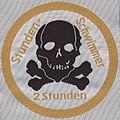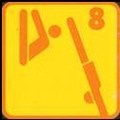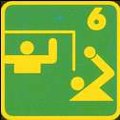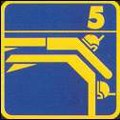Swimming badge
A swimming badge , in Switzerland the swimming test , is a sports badge and is an award in swimming . After passing the test, the swimmer receives a colored fabric badge that can be sewn onto the swimwear. There is also a swimming pass or swimming ID .
Germany
The statements refer to Germany up to the post-war period and to the Federal Republic. For the GDR (1949 to 1990) see swimming badges (GDR)
General swimming badges
The examinations for beginners in swimming, the German Youth Swimming Pass, the German Swimming Pass, the German Competitive Swimming Pass and the lifesaving tests are set out in the "German Swimming Examination Regulations". It has been published since 1977/78 by the swimming associations and the Conference of Ministers of Education and Science, which are part of the Federal Association for the Promotion of Swimming Education (BFS) .
Exams for beginners
- Early swimmer "seahorses" (under 18 years)
- Swimming certificate for adults (from 18 years)
German swimming pass
Swimming badge of the DSV
The German Swimming Association (DSV) has developed further qualifications and badges. The instructors of the other associations in the BFS are also authorized to take examinations.
Swimming badge "pirate"
100 m technically appropriate swimming, 5 m distance diving with subsequent retrieval of an object from at least 1 meter water depth.
Versatility badge "Seehund Trixi"
25 m breaststroke , 25 m back or crawl swim , 15 m dribbling with a beach ball in the water, forward head jump , 7 m diving , 1 roll forwards or backwards around the transverse or longitudinal axis in the water.
German competitive swimming pass
Lifeguard badge
The junior rescuer or junior water rescuer provides general basic training in self-rescue and simple rescue by others.
The German Lifeguard Badge (DRSA) distinguishes the ability to rescue swimmers who have had an accident.
This is offered by all aid organizations with a water rescue service, including the ASB water rescue service.
Older and rare swimming badges
German youth swimming pass (under 18 years)
Until 2019, the three-tier German youth swimming pass (gold, silver, bronze) was awarded to children and young people under the age of 18. With the amendment to the German Swimming Examination Regulations on January 1, 2020, the German Youth Swimming Pass was abolished in favor of a general German swimming pass for children, teenagers and adults.
Free swimmers, speed swimmers and youth swimmers
In the 1950s until the introduction of the above regulation in the early 1980s, the following swimming badges were used in Germany:
- Seahorses (jump from the edge of the pool and swim 25 m as well as picking up an object with your hands from shoulder-deep water)
- Free swimmer (15 minutes swimming in deep water and jumping from 1 m height)
- Speed swimmer (30 minutes swimming in deep water and jumping from a height of 3 m into 3.5 m deep water or, if prerequisites are not met, any 3 jumps)
- Competitive swimmers (10 minutes swimming in deep water; 50 m swimming in the supine position without arm or hand movements; 10 m distance diving; 2 m deep diving; 10 m rescuing someone of the same age who represents the drowning person)
- Youth swimming license (conditions to be fulfilled within 2 months):
- Course swimming: 200 m in any style
- Fast swimming: 50 m in any style in standing water, max. 70 seconds
- Backstroke: 25 m, of which 15 m without arm activity (arms should be crossed over the chest)
- Distance diving: 10 m (measured from the jump)
- Plate or ring diving: 3 out of 6 plates (rings) on a 5 × 5 m surface area in 1 to 3 dives, 3 min. time
- Leap of courage: any jump from a height of 3 m into 3.5 m deep water or, if the requirements are not met, any 3 jumps
- Transport: 30 m pulling or pushing someone of about the same weight
- Proof of the following knowledge: general bathing rules, self-help in the event of dangers on and in the water (swimming, boat and ice accidents)
- Dolphin (in the order seahorse - dolphin - shark)
Different rules and badges applied in the territory of the GDR .
Skull swimmer
They are also known
- Skull swimmer in black (one hour swim)
- Skull swimmer in silver (one and a half hours swimming)
- Skull swimmer in gold (two hours swimming)
The skull badges were very popular, but have only rarely been removed since the early 1970s, as there were frequent cases of hypothermia . Individual swimming pools still take the test, provided the water temperature is appropriate. DLRG structures, on the other hand, are now prohibited from accepting them without exception, as the badges do not correspond to the content of the German Swimming / Lifeguarding Examination Regulations, which has been declared binding. Some bathing companies have now issued strict regulations that the test may only be carried out with people who the examiners - mostly from previous swimming courses - know that they have the necessary physical constitution. The skull swimmers do not belong to the official swimming badges of the German examination regulations for swimming / lifeguarding.
Austria
The Austrian swimmer badges are issued by the Austrian Water Rescue Association (ARGE ÖWRW). The Austrian Workers' Samaritan Association (water rescue), the Austrian Youth Red Cross and the Austrian Water Rescue have joined forces. The Federal Ministry of the Interior (BMI) and the National Defense (BMLV) also belong to it, but they only train in the service area. The Federal Ministry for Education, Science and Research (BMBWF) is an advisory member.
The Austrian swimmer badges are available in the following levels:
Switzerland
The Swiss swim tests are a comprehensive methodological and didactic concept for learning to swim. They are published by the association of associations and institutions in Switzerland interested in swimming, " swimsports.ch ", the Swiss Swimming Association , the Swiss Lifesaving Society (SLRG) and the Youth + Sport organization of the Federal Office for Sport FOSPO .
Methodical didactic help in swimming lessons
The 65 swimming tests are a didactic aid for all swimming teachers. They help to methodically structure the lessons, set goals and review performance, and at the same time provide methodical guidance for exercises that build on one another. The tests and the execution of the individual exercises are explained in detail on picture boards. The lower levels can be accepted by anyone (anyone who has understood the provisions and instructions and is willing to follow them exactly ). This is particularly useful for methodical support for parents who want to teach their children to swim themselves. Particular emphasis is placed on playful communication and diversity. Technically, the beginner tests focus on water position, breathing and coordination. The advanced tests require high technical and physical performance and prepare for top-class sport.
The extensive teaching material is provided free of charge. The costs are borne by well-known sponsors. The embroidered fabric badges are sold at cost.
Categories and swim tests
- Motivation badge
Six tests are offered in the area of water habituation: duck , swan , seal , hippopotamus , turtle and beaver .
- Basic tests
Seven tests are offered for beginners in swimming: cancer , sea horse , frog , penguin , octopus , crocodile and polar bear .
- swim
Eight tests are offered for swimmers and advanced users: whale , pike , shark and dolphin , as well as test 5 to test 8 .
- Combination tests
The combination tests combine swimming, diving, jumping and rescue. There are tests in four stages. With the technical explanations they contain, they offer teachers a suitable working basis for swimming lessons in middle and high school. The diverse basic training associated with this can prepare for a later specialization. These tests have been around since 1956.
- Special tests
In the categories diving , synchronized swimming , water polo , lifeguard swimming and fin swimming , there are special tests in eight levels each. Tests 5 to 8 may only be carried out by trained persons, tests 7 and 8 in some cases only by certified competition judges.
Water safety check
The Water Safety Check (WSC) checks whether a person can save himself or herself to the edge or bank if he falls into the water. In contrast to swimming lessons, which are concerned with staying in the water free of fear and in which getting used to the water, coping with the water and performing clean movements of the core movements and swimming techniques are the essential contents, the WSC is all about self-rescue .
The WSC pass confirms to the child, their parents and other supervisors that the child has successfully completed the WSC and is sufficiently competent in water to be allowed into the - supervised - deep water. Children with a WSC ID can also access many pools in Switzerland without an adult.
The sequence:
- Roll / tumble in deep water
- Hold in place for 1 minute above water
- Swim 50 m
The water safety check was developed in Canada under the name “Swim to Survive®” by the Canadian Lifesaving Society. The sponsors are swimsports.ch, Swiss Lifesaving Society SLRG, Swiss Swimming Association SSCHV, Youth and Sport J + S and the bfu - Advice Center for Accident Prevention.
Job qualifications
The SLRG offers training in life-saving swimming (requirement for pool supervisors, teachers, youth leaders), swimsports.ch trains swimming instructors and youth and sport trains youth leaders in swimming, diving, diving, water polo, life-saving swimming and artificial swimming. The graduates are also awarded a swimming badge.
- Brevet I - Lifeguard (requirement for teachers and youth leaders)
- Brevet II - course instructor (requirement for sports instructors and swimming instructors)
- Brevet III - Senior Expert
- Head of youth + sport - youth group leader
- Swimming instructor - specialist instructor for swimming, diving, diving, lifeguarding
Netherlands
In the Netherlands , the Royal Dutch Swimming Federation ( Koninklijke Nederlandse Zwembond , KNZB), founded in 1890, awarded the first swimming diplomas from 1892. Other swimming associations also subsequently awarded their own diplomas; In 1937 these were standardized across the country and swimming training according to the KNZB system became the basis of the nationwide standardized swimming lessons . In 1946 the swimming diploma was reformed and from then on it was issued in two stages:
- Diploma 1: Beginner's diploma
- Plunge into the water, swim 125 m (chest 75 m, back 50 m), diving
- Diploma 2: Diploma for experienced swimmers
- Head jump, dressed, from the starting block, 50 m breaststroke in clothes; Plunge and swim 150 m (100 chest, 50 m back, of which 25 m with hands on chest), diving
With effect from August 1, 1984, a three-stage (A, B and basic swimming diploma), national swimming diploma was introduced across the country, replacing the previous systems. From 1998 there was another change, whereby the three-stage swimming ABC was introduced. The diploma is awarded centrally by the National Platform Zwembaden . The swimming training is primarily geared towards being able to save yourself in the water at any time. Four-year-olds can already take the swimming ABC; those who have achieved the C diploma are considered to be able to swim safely. The swimming ABC is divided into the diplomas A, B and C, which are associated with increased requirements. Integral part of swimming training is the clothes swimming .
From 1953 to 1985 there were also 4 'swimming skills diplomas' for advanced swimmers in the Netherlands. In 1985 the number of swimming skills diplomas was first reduced to three. Since then, various swimming diplomas have been added, such as B. Snorkeling, survival, synchronized swimming, world swimming strokes and water polo. In the meantime, there are even up to 24 additional swimming diplomas for water rats, in addition to the swimming ABC.
See also
Web links
- Swimming badges in Germany on the DLRG website
- Swimming tests in Switzerland , swimsports.ch
Individual evidence
- ^ Federal Association for the Promotion of Swimming Training (Ed.): German Swimming Examination Regulations (with Rescue Examination Regulations) . Bad Nenndorf December 2019 ( bfs-schwimmausbildung.de [PDF; 97 kB ; accessed on January 9, 2020]).
- ↑ Federal Association for the Promotion of Swimming Training (Ed.): "Safe swimming ability" redefined as the primary goal of swimming training . Bad Nenndorf December 5, 2019 ( bfs-schwimmausbildung.de [PDF; 3.2 MB ; accessed on January 9, 2020]).
- ↑ Information on free swimmers, speed swimmers and young people's swimming license: DLRG youth swimming pass, as of June 24, 1966
- ↑ Hans Scharrer: Textbook for lifeguards . Ed .: Bavarian Red Cross, Department of Water Rescue. Munich 1957, practical training / swimming, p. 43 .
- ↑ z. B. KölnBäder GmbH, Berlin baths companies
- ↑ Brief contents of the Swiss swim tests ( Memento from August 25, 2011 in the Internet Archive )
- ↑ Swiss Swimming Association: Swimming tests ( Memento from July 26, 2011 in the Internet Archive )
- ↑ zwem ABC , Nationaal Platform Zwembaden | NRZ, accessed on April 28, 2015
- ↑ Zwemvaardigheidsdiploma's. In: www.npz-nrz.nl. National Platform Zwembaden | NRZ, accessed December 6, 2016 .














